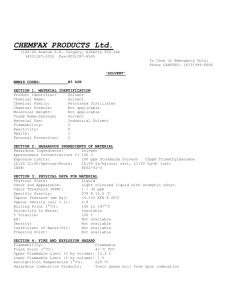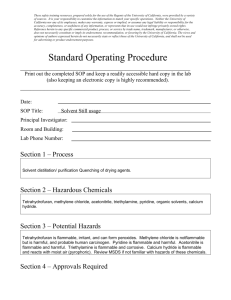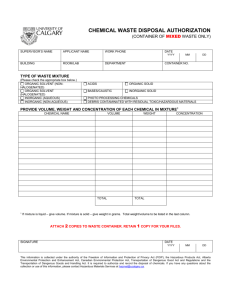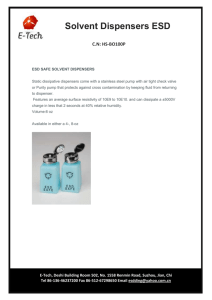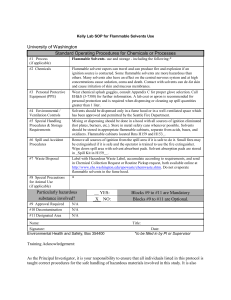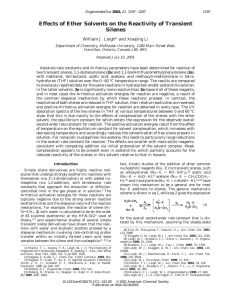Solvent Purification System
advertisement
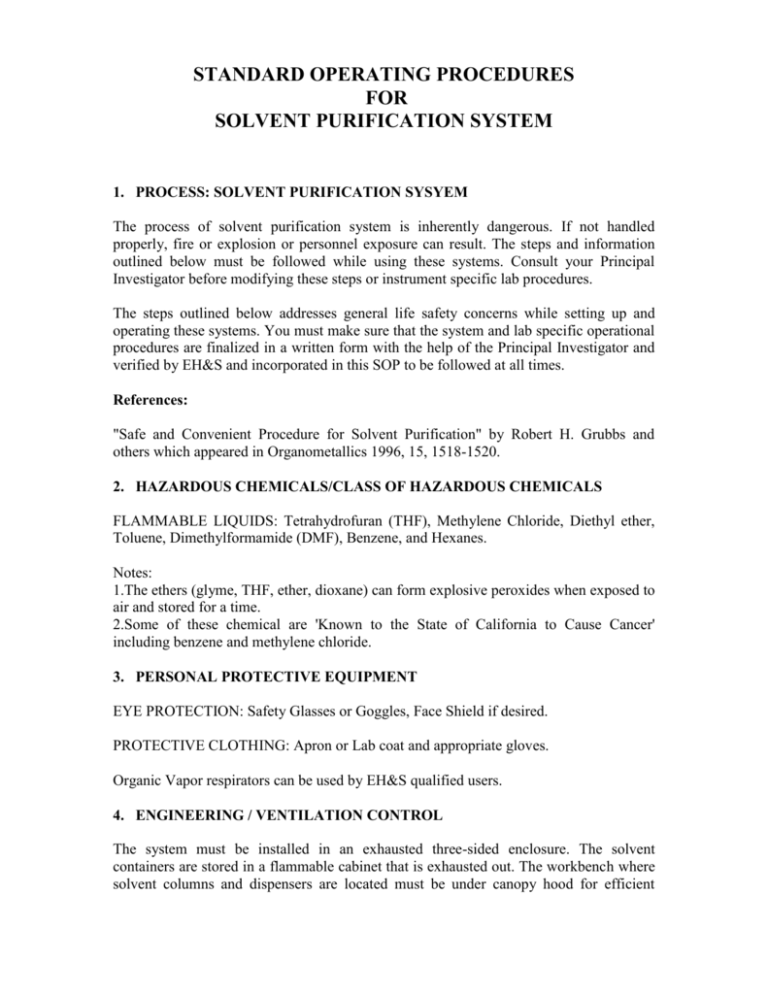
STANDARD OPERATING PROCEDURES FOR SOLVENT PURIFICATION SYSTEM 1. PROCESS: SOLVENT PURIFICATION SYSYEM The process of solvent purification system is inherently dangerous. If not handled properly, fire or explosion or personnel exposure can result. The steps and information outlined below must be followed while using these systems. Consult your Principal Investigator before modifying these steps or instrument specific lab procedures. The steps outlined below addresses general life safety concerns while setting up and operating these systems. You must make sure that the system and lab specific operational procedures are finalized in a written form with the help of the Principal Investigator and verified by EH&S and incorporated in this SOP to be followed at all times. References: "Safe and Convenient Procedure for Solvent Purification" by Robert H. Grubbs and others which appeared in Organometallics 1996, 15, 1518-1520. 2. HAZARDOUS CHEMICALS/CLASS OF HAZARDOUS CHEMICALS FLAMMABLE LIQUIDS: Tetrahydrofuran (THF), Methylene Chloride, Diethyl ether, Toluene, Dimethylformamide (DMF), Benzene, and Hexanes. Notes: 1.The ethers (glyme, THF, ether, dioxane) can form explosive peroxides when exposed to air and stored for a time. 2.Some of these chemical are 'Known to the State of California to Cause Cancer' including benzene and methylene chloride. 3. PERSONAL PROTECTIVE EQUIPMENT EYE PROTECTION: Safety Glasses or Goggles, Face Shield if desired. PROTECTIVE CLOTHING: Apron or Lab coat and appropriate gloves. Organic Vapor respirators can be used by EH&S qualified users. 4. ENGINEERING / VENTILATION CONTROL The system must be installed in an exhausted three-sided enclosure. The solvent containers are stored in a flammable cabinet that is exhausted out. The workbench where solvent columns and dispensers are located must be under canopy hood for efficient removal of leaking vapors. Pump exhaust is vented to the laboratory exhaust system. Ensure solvent trap is used on the vacuum pump using oil. Secondary containment is provided under the columns and dispensers. 5. SPECIAL HANDLING PROCEDURES AND STORAGE REQUIREMENTS Display and follow the lab specific written procedures for the whole system like solvent transfer, degassing, dispensing, titration, etc. For peroxide forming solvents that might be exposed to air over an extended period of time - peroxide tests should be conducted according to PS CHP (section 4.42.2). Benzene is a confirmed human carcinogen - avoid inhalation and skin contact. Handle it either inside the fume hood or wear an approved respirator. Methylene chloride is also a suspect human carcinogen and there is no approved respirator for this solvent. Label the hazardous materials with their full name (i.e. tetrahydrofuran not THF). Store the flammables in the approved flammable storage cabinets before they are transferred into the reservoirs for purification. Approved flammable cabinets must have automatic door closures. Use secondary containment carriers whenever transporting hazardous material outside of the lab. Use due care and caution when moving hazardous materials around anywhere. 6. SPILL AND ACCIDENT PROCEDURES Keep a 5-gallon universal spill kit from the PS Store near the solvent purification system, which can be used for small incidental spills. For large spills - isolate the spill if possible, evacuate area, keep people away, and Call for help: EH&S (8 AM - 5 PM) - 949-824-5073, from campus phone ext. 4-5073. UCI POLICE (24 HOURS) - Dial 911 OR 949-824-5223 when using outside line or cell phone. 7. WASTE DISPOSAL Dispose of any hazardous waste generated by this system through UCI EH&S by completing a Hazardous Waste Pick up Form and faxing it to EH&S at 4-9180. PARTICULARLY HAZARDOUS SUBSTANCES ONLY 8. APPROVAL REQUIRED N/A 9. DECONTAMINATION PROCEDURES 116107529 2 N/A 10. DESIGNATED AREA N/A These safety training resources, prepared solely for the use of the Regents of the University of California, were provided by a variety of sources. It is your responsibility to customize the information to match your specific operations. Neither the University of California nor any of its employees, makes any warranty, express or implied, or assumes any legal liability or responsibility for the accuracy, completeness, or usefulness of any information, or represents that its use would not infringe privately owned rights. Reference herein to any specific commercial product, process, or service by trade name, trademark, manufacturer, or otherwise, does not necessarily constitute or imply its endorsement, recommendation, or favoring by the University of California. The views and opinions of authors expressed herein do not necessarily state or reflect those of the University of California, and shall not be used for advertising or product endorsement purposes. 116107529 3

